Bomb craters (10) - shell craters
Posted: 14 April 2013 10:31
A landscape feature that I've not yet covered in this series is what would have been the most numerous type of crater in Sussex - those made by artillery shells. A visit to the site of a live-fire exercise reveals some interesting evidence.
The South Downs Battle Training Area took a real hammering from artillery and mortars; certain areas were set aside into which all manner of explosive ordnance plunged on an almost daily basis from 1941. These areas were predominantly agricultural land and the thousands of pock-marks visible on 1946 aerial photographs have long since been ploughed out.
However, I did find documents in a war diary describing an area that might still bear evidence of past traumas.
Fire support demonstration
We have to go back to April 1945 - surprisingly late in the European war, but I suppose I've always had the impression that large-scale exercises pretty much ended with the opening of the Second Front in 1944. This is not so - troops were continuously coming and going between the UK and the continent and although the end seemed near, the war was not over yet and certainly not in the Far East.
55 Division were in Sussex at this time and had been tasked with rapidly training up troops who were urgently needed for overseas deployment. Shortages were such that many anti-aircraft regiments were being disbanded and men being sent back to the UK for retraining to become infantry.
As part of their training, a fire support demonstration was staged on the Downs; this comprised a large number of set-piece bombardments from the following:
- A platoon of 4.2-inch mortars (4)
- A platoon of 3-inch mortars (6)
- A Field Regiment of 25-pounder guns (24)
These weapons are illustrated in the graphic below:

The fire was to be directed onto two target areas. Unfortunately, the documents didn't give any grid references for these areas. However, a grid was given for the location of the spectators, and even better, a thumbnail sketch of the area from that point was included as part of the fire orders!
I've very roughly redrawn the sketch freehand below, with a photo showing the same view. The sketch exaggerates the shape of the Downs, but, allowing for the growth of vegetation, it's a fairly close match with the landscape of today! Targets 'I' and 'II' are marked.
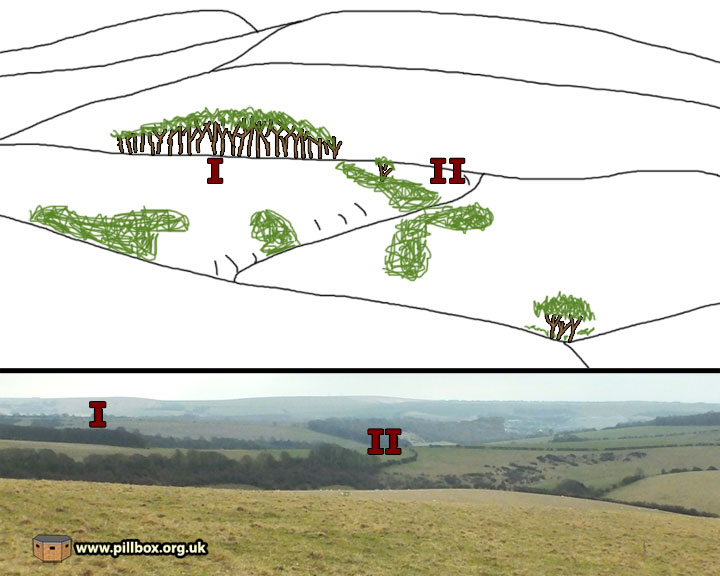
The fire plan
The fire plan is shown in full in the table below; if you're not inclined to wade your way through the minutiae of it, I'll just draw your attention to the highlighted fire mission, Serial no.6.
| Serial | Qty | Weapon | Type of Fire | Target | Duration | Rounds |
|---|---|---|---|---|---|---|
| 1 | 6 | 3-inch mortar (Platoon) | High Explosive | 1 | 1 min | 80 |
| 2 | 1 | 4.2-inch mortar | High Explosive | 1 | 1 min | 8 |
| 3 | 4 | 4.2-inch mortar (Platoon) | High Explosive | 1 | 1 min | 40 |
| 4 | 4 | 25-pounder (Troop) | High Explosive | 2 | 1 min | 20 |
| 5 | 24 | 25-pounder (Regiment) | High Explosive | 2 | 1 min | 120 |
| 6 | 24 | 25-pounder (Regimental concentration) | High Explosive | 2 | 1 min | 120 |
| 6 | 3-inch mortar (Platoon) | 1 | 160 | |||
| 4 | 4.2-inch mortar (Platoon) | 1 | 40 | |||
| 7 | 1 | 3-inch mortar | Smoke | 1 | 30 sec | 5 |
| 8 | 1 | 4.2-inch mortar | Smoke | 1 | 30 sec | 5 |
| 9 | 4 | 25-pounder (Troop) | Smoke | 2 | 30 sec | 4 |
| 10 | 8 | 25-pounder (Battery) | Smoke | 2 | 1 min | 40 |
| 4 | 4.2-inch mortar (Platoon) | 1 | 40 | |||
| 6 | 3-inch mortar (Platoon) | 1 | 80 |
Consider the spectacle of Serial no.6; 320 rounds of high explosive screaming down onto both target areas all within one minute. The cacophony of the guns and mortars firing, the puff of smoke followed by the delayed thud of detonation pounding your eardrums, the vibration of every round smashing into chalk downland rippling along the valley, up the hill and rattling your ribcage.
I've attempted to illustrate all this visually with the Photoshopped picture below; target 1 took the mortar stonk while target 2 was on the wrong end of a full regimental concentration - 24 field guns zeroed in on the same area. This volume of fire into a hillside unlikely to have been ploughed post-war must surely still bear some evidence?

The craters
I made two visits to target no.2; the weather was not favourable on either occasion. My initial visit was cut short by my feet going numb in the exceptionally cold early spring weather.
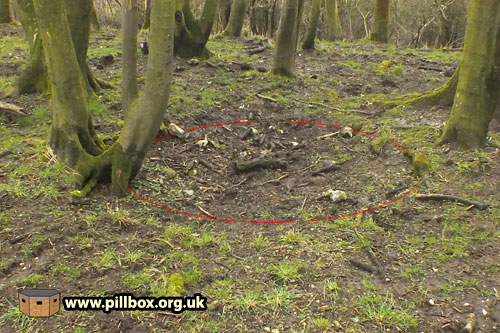
However, this exploratory foray into a hillside copse beside a public footpath yielded the evidence I was looking for - shell craters!
The photo at right shows one of about four or five that I identified; my uncertainty in the number will be explained in due course.
This crater was 2.4m in diameter and about 25cm deep; too shallow to photograph well, hence the red ring to indicate it in the photograph.
The ground in this area was quite rough and bumpy; given the number of rounds that hit this hillside I wasn't surprised, and I was quite confident that I was looking at shell craters.
Another one is shown below; again, not easy to photograph without sunshine and shadow. This one was also about 2.4m across.
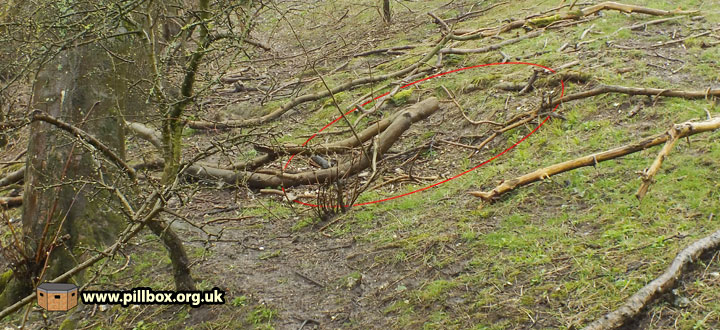
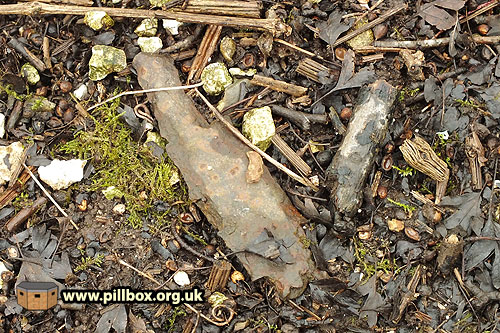
This second crater was about 40m from the first and other possible craters were noted in the area.
A lot of animal activity has also churned up the landscape; numerous rabbit holes and sheep tracks are present.
A few pieces of shell splinter were also evident, such as that shown at right.
The Downs in places are still strewn with this stuff, so to see a handful of fragments here was no surprise, especially given the known activity at this site.
This fragment may even have come from a shell fired during our fire support demonstration, but as this hillside was in use as a firing range from 1941, it could date to any time during that period.
End of expedition
A second visit in pouring rain brought some discoveries that I wasn't wanting - live bombs!
I find something rather ironic in that, having roamed the Downs for 30 years and not found any live ordnance during that time, I should find unexploded bombs twice in one week, 20 miles apart! Read about last Saturday's find.
Again, these were 2-inch mortar bombs, as shown below. The inset image shows one that has actually been broken in half, possibly by a cow standing on it, judging by the hoof-prints surrounding it.
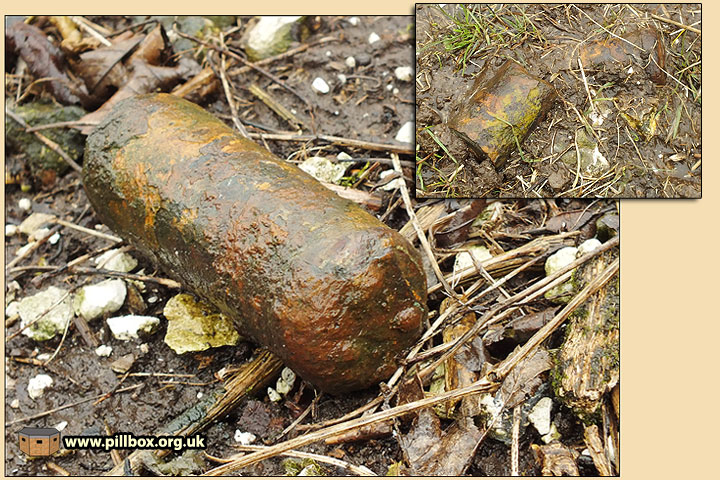
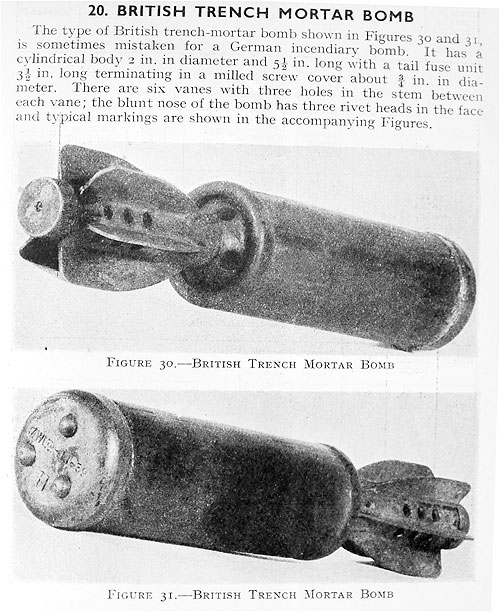
The presence of 2-inch mortar rounds proves that this area was not just used for the fire support demonstration, as we know that this smaller weapon was not used on this occasion.
I walked back towards civilisation in order to get a phone signal and set the same process as last week in motion.
The police duly arrived and I showed them to the site.
In order to prove these were bombs, I had downloaded the image at right from last week's blog post onto my mobile.
Note the three rivets on the nose of the bomb; you can just make these out in the photo above.
The police had also noted my previous call and seen the outcome and so they readily accepted what I was saying.
As were were walking the ground, we found a further two devices, making a total of five.
As it was now late in the day and the EOD team were not going to attend until the following day.
In the event, I didn't get to visit target 1; in any case, the land is fenced off and private. I informed the police as to the potential presence of further ordnance in that area and left them to guide the EOD team.
Despite this foreshortening of my fieldwork, it was interesting to be able to identify some landscape evidence in target 2. These are the only shell craters that I can positively identify on the Downs and they are an important reminder of how the landscape was changed in four short years. Their absence today in the most prolific artillery target range elsewhere on the Downs also indicates how farmers reclaimed their devastated land and ploughed out the lunar landscape.
The fire support demonstration also gives us a valuable insight into the sheer volume of fire that such a small area could be subjected to - in this demonstration, a total of 737 rounds of smoke and high explosive crashed into the targets - and that was just in 30 minutes!
Although this expenditure of ammunition was more typical of the latter years of the war than the early years of shortage, we can see why some ordnance was overlooked and only now is coming back to the surface.
In order to get an accurate number of the craters, I need to go back sometime and check my data.
However, given my recent record of finding bombs, next weekend I'm staying at home...
- Pete

Email:
Blog Latest

Bishopstone reveals its pillbox secrets
18 October 2021

Pillbox or Observation Post?
10 June 2020

Uncovering the hidden secrets of a pillbox
8 June 2019

Review of 2018
31 December 2018

Wartime Christmas in East Sussex (2)
24 December 2018
Jargon-buster
War diary
A record of events kept by all units from the point of mobilisation. A diary's contents vary enormously from unit to unit; some give detailed entries by the hour on a daily basis while others merely summarise events on a weekly/monthly basis.
This site is copyright © Peter Hibbs 2006 - 2024. All rights reserved.
Hibbs, Peter Bomb craters (10) - shell craters (2024) Available at: http://pillbox.org.uk/blog/216724/ Accessed: 27 July 2024
The information on this website is intended solely to describe the ongoing research activity of The Defence of East Sussex Project; it is not comprehensive or properly presented. It is therefore NOT suitable as a basis for producing derivative works or surveys!